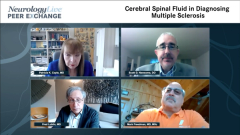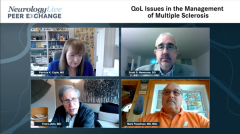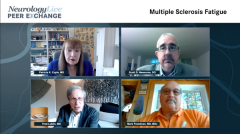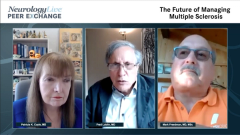
Cladribine for Treatment of RMS
Episodes in this series

The panel reviews the use of cladribine for treatment of relapsing multiple sclerosis, including patient selection.
Fred Lublin, MD: Let’s take a look at cladribine. Mark?
Mark Freedman, MD, MSc: Our discussion brings me to the mechanism of a drug like cladribine.
I know that the terminology of so-called immune reconstitution isn’t something that is commonplace in the United States, but the whole point is that a drug and treatment like cladribine has been around for quite some time. We moved to this well after it was obvious that mitoxantrone was causing a problem, but we like mitoxantrone. It was probably 1 of the prototypic immune reconstitution drugs because it had its built-in limitation. You could give only so much. But if you followed these people, as the French did for years, they saw that 5 to 7 years down the road, these patients didn’t need anything else. That gave us the idea that maybe there are other therapies one could use. Cladribine treatment is similar.
It’s based on the notion that there’s a certain dosage that will control the disease. This is given like a cancer drug in select treatment groups. It is administered 1 week of the month, times 2 in the first year. Administration is the same in the second year, but the cumulative dose is 3.5 mg/kg. That’s the dose that was studied in the CLARITY trial, both in the original study and in the extension going out 4 or 5 years. It’s a unique study. It’s also a gutsy study, because they answered the question that the B-cell people have not. They took the people who were randomized to the alternative therapy and gave them the drug. But at the same time, after a few years of taking cladribine, they stopped the drug randomly. They didn’t tell them. They kept them blinded and moved them to placebo to see what happened. That’s what happened in the extension.
The overall results from the clinical end point were that the people who had 4 successive years of cladribine were no better clinically than those that had only 2 years and then 2 years of placebo. This tells you that the up-front treatment has some durability, and we’ve seen the same thing with alemtuzumab. That is the other prototypic induction agent with which you knock down the immune system, allow it to recover over time, and then watch for the durability of the response. That’s the uniqueness of cladribine.
Knowing how the drug works and that it’s highly efficacious, an additional study went after the CIS [clinically isolated syndrome] population. At that time, the group probably included about half the patients who today would have met the McDonald 2017 criteria for MS diagnosis. Regardless, they went after this early treatment group. One could have anticipated that the results from the ORACLE study weren’t much better than in any of the other CIS trials. Those were done with only the injectables. The only oral tested was teriflunomide.
With cladribine, you have this dose induction. Let’s wait and see, and follow the patients for a few years. The option is there to re-treat if you needed to, but you can get a durable response from the focused-set therapy based on surface area or weight.
Scott D. Newsome, DO: For cladribine, I would say in full transparency that I haven’t used it a lot. I do have some patients on it. As you said, Mark, it does have this durable treatment effect. It’s a short course. Its oral. The people I have put on this medication have had great tolerance to it. They love the fact that for 2 months, they do the treatment, and they don’t have to do anything for the next 8 months. There is also the possibility of not having to continue a therapy after 2 years of treatment, or to at least have an extended period of time when you don’t have to do another treatment. It does remind me of the mitoxantrone induction. It may be possible to put someone on a lower-efficacy therapy like Copaxone [glatiramer acetate], which was done in the past. I don’t know if this will be brought back to life with cladribine. Alemtuzumab was also mentioned.
The 1 caution that I have is that cladribine, alemtuzumab, and other high-efficacy drugs aren’t cures. Even if you’re reboosting the immune system, I don’t think we have a lot of data yet to support that notion, at least with cladribine and alemtuzumab. I feel uncomfortable, as many of our other patients feel uncomfortable, not just doing the watchful waiting approach and having that reactive approach to treatment after you use a therapy like cladribine.
It is effective. I would lump it into a higher-efficacy bucket. In fact, for our PCORI [Patient-Centered Outcomes Research Institute]–funded trial looking at modestly-effective vs high-efficacy medications, cladribine was put into the high-efficacy bin because of the clinical trial data that Mark just went over.
Patricia K. Coyle, MD: Cladribine is a very interesting agent. I consider it the most efficacious of the oral therapies. It’s not as efficacious as the monoclonal antibodies. The greatest difficulty is that in the United States, the label says you give your 2 courses and then they’re silent. That’s a big issue. That needs to be resolved.
Scott D. Newsome, DO: Can I make 1 other comment about how cladribine, potentially the B-cell–depleting therapies, and even alemtuzumab have a leg up on some of the other therapies we have in pregnancy? A lot of us are using these medications that have a durable treatment response in patients who have an interest in getting pregnant but who you’re worried about, from a disease activity perspective. We’ve been using these therapies in that fashion, as opposed to maybe natalizumab or fingolimod. You think, “OK, if I stop the drug today, we have a potential issue with rebound attacks because you have to wash the drug out, or at least it’s recommended to wash the drug out for a little while.” That’s where I like using the therapies that are B-cell depleters vs just blocking cells.
Newsletter
Keep your finger on the pulse of neurology—subscribe to NeurologyLive for expert interviews, new data, and breakthrough treatment updates.


































